Last Updated on July 18, 2023 by Maged kamel
- List of compression Member Posts-part 1.
- Steel columns and Euler's formula-Two parts.
- Buckling for columns – effective length factors.
- Column compressive strength-Analysis problem.
- How to compute critical stress by table 4-22?
- A Solved Problem 4-9 For available compressive strength.
- Alignment charts for columns.
- Solved problem 7-1 for the alignment chart for columns.
- Solved Problem 13-28 For Compression Members.
- Solved Problems for column analysis.
- 10-Introduction to Local Buckling.
List of compression Member Posts-part 1.
Steel columns and Euler’s formula-Two parts.
This is the first post of the compression member Posts-part 1, which has several posts for discussion. The first item, What is the definition of compression members? The second point will be Euler’s equation the derivation of Euler’s equation. The third point is what is buckling. The next image shows the Euler equation for stresses.
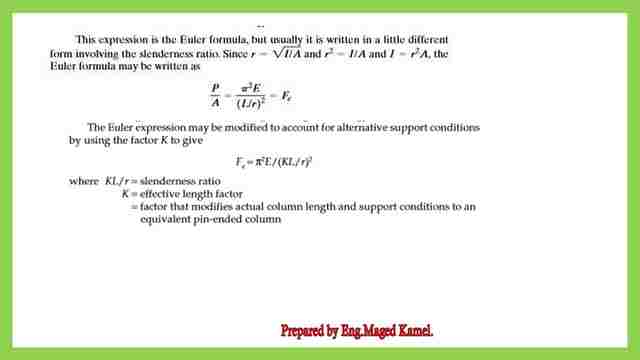
This is a link to the first post.
This is a link to the second post-1a.
Buckling for columns – effective length factors.
This is the second post of the compression member Posts-part 1, which also contains the discussion of the buckling of the columns. If we apply an axial force to a straight column and gradually increase it. The Load will eventually reach a value known as Pcr, which will cause the column to buckle.
As previously stated, the Pcr is the critical buckling load. Buckling occurs when a straight column is acted upon by compression force it will be converted to another form having a bending moment as shown in Figure 1b earlier it was plumb later to a deformed shape. There is a given solved problem as shown.
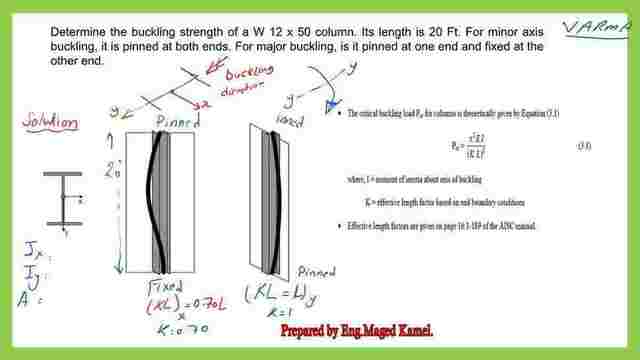
Buckling is identified as a failure limit state, the shape of failure for that column.
The link to post 2: Buckling for columns – effective length factors.
Column compressive strength-Analysis problem.
This is the third post of the compression member Posts-part 1, which includes a solved problem 4.2 From Prof. William T Segui’s handbook. solved problem 4.2 (estimate design compressive strength).
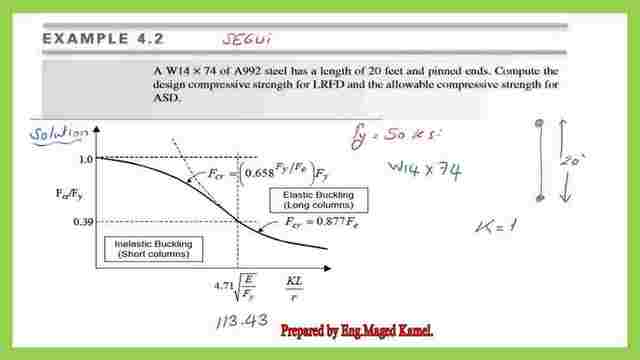
The link to post 3: Column compressive strength.-Analysis problem.
How to compute critical stress by table 4-22?
This is the 4rth post of the compression member Posts-part 1, which includes Our subject will be how to estimate the compressive strength by using tables.
The controlling factor, that Differentiates between short columns and long columns are the criteria, of Kl/r, we evaluate the maximum value whether in x or y-direction.
The maximum kL/r value will give the minimum compressive strength value.
The link to post 4: How to compute critical stress by table 4-22? The following post image, explains the LRFD value estimation by using table 4-22.
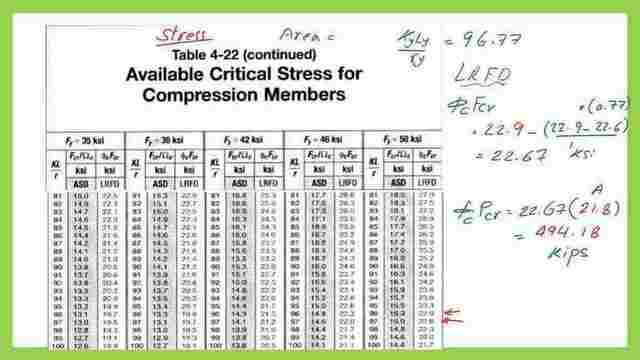
A Solved Problem 4-9 For available compressive strength.
This is the 5th post of the compression member Posts-part 1, which includes the solved problem, 4-9.
A solved problem example From Prof. William T Segui’s handbook solved problem 4.9 A W12×58, 24 feet long, is pinned at both ends and braced in the weak direction at the third point, as shown in Figure 4.11. A992 steel is used.
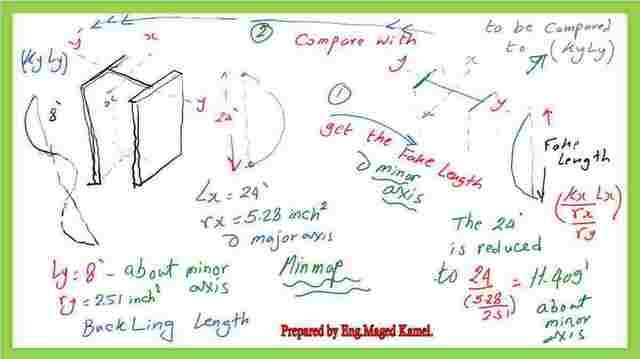
Determine the available compressive strength.
The link to post 5: A Solved Problem 4-9 For available compressive strength.
Alignment charts for columns.
This is the 6th of the compression member Posts-part 1, which includes a new subject which is the use of the alignment chart relating to columns when attached to frames, whether braced or not. This graph was done by Anderson and Woodward or Nomograph or Andersons and Woodward.
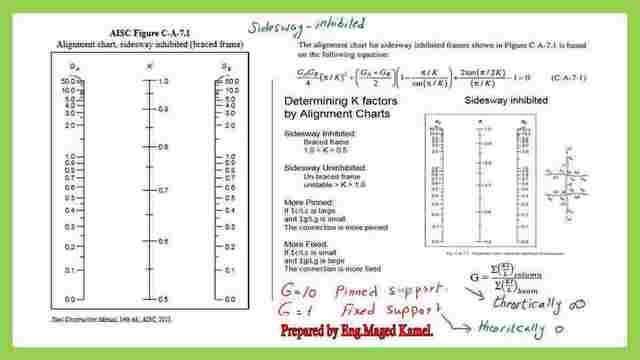
But this method is based on certain assumptions, that the column is elastic and the beam is elastic if there is a violation of that conditions, and the adjusted factor is to be used If the column is inelastic.
The link to post 6: Alignment charts for columns.
Solved problem 7-1 for the alignment chart for columns.
This is the 7th post of the compression member Posts-part 1, which includes a solved problem 7.1 from Prof. Mccormack’s book. Determine the effective length factor for each of the columns of the frame shown in Fig.7.4.
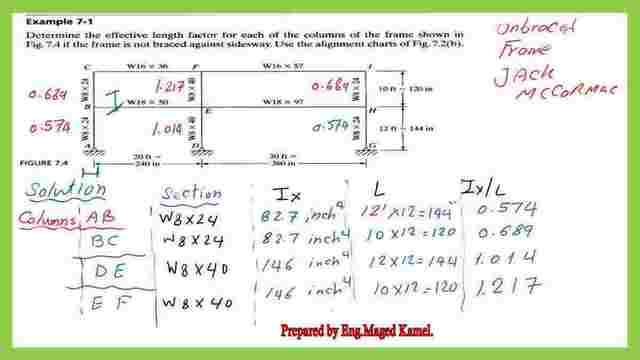
If the frame is not braced against the side-sway. Use the alignment charts of Fig.7.2(b).
The link to post 7: Solved problem 7-1 for alignment chart for columns.
Solved Problem 13-28 For Compression Members.
This is the 8th post of the compression Member Posts which includes a Solved problem 13.28. The example from M.Iqbal. A w12 x50 is used as a column as shown, Fy=50 ksi, the support is fixed at the bottom, and with guide roller at the top, it is required to estimate the available strength in axial compression in kips.
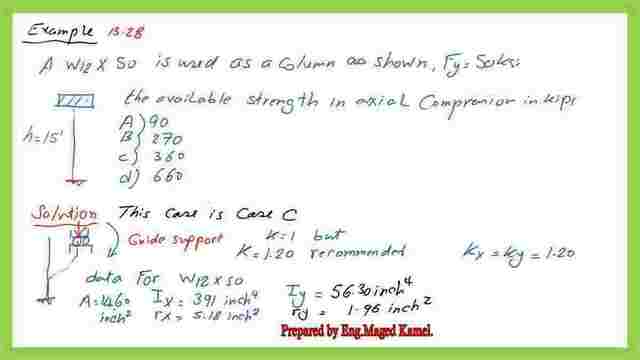
Select the correct answer from the following options 1) 90 kips, 2)270 kips 3)360 kips 4)660 kips. The link to post 8: Solved Problem 13-28 For Compression Members.
Solved Problems for column analysis.
This is the 9th post of the compression Member Posts which includes two Solved problems- 13.28A from M.Iqbal. is used as a column as shown, Fy=50 ksi, the support is fixed at the bottom, and with guide roller at the top, it is required to estimate the available strength in axial compression in kips.
Select the correct answer from the following options 1) 500 kips, 2) 460 kips 3)580 kips 4) 600 kips.
the second solved example 13-29.
We have a column W10x45 of 20′ long and is braced in the x-direction with roller support at the top and hinged support at the bottom, while in the y-direction. The column is supported also at the middle by roller support, fy=50 ksi, its controlling slenderness ratio is mostly near A) 5, B) 65, c) 72, D) 120.
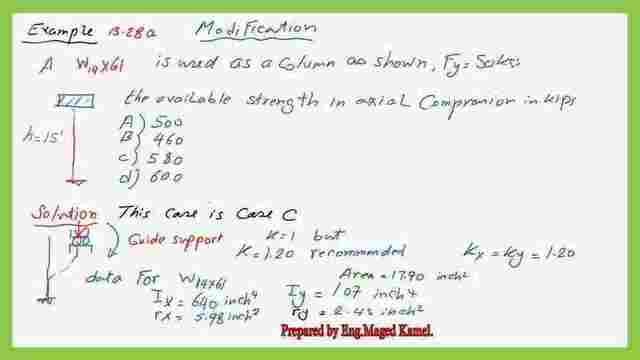
This is post 9: Solved Problems for column analysis.
10-Introduction to Local Buckling.
This is the 10th post of the compression Member Posts which includes We have been through the subject of local buckling for beams and have talked about the coefficient of local buckling for both flange and web for beams and talked about the general Condition. There are three types, compact, noncompact, and slender sections.

This is post 10: Introduction to Local Buckling. This is part-1.
This is a link to post 10a, which is the second part.
List of compression Member Posts-part 2.
List of compression Member Posts part -3.
This is a link to An external source for compression members from Prof. T. Bartlett Quimby’s site, this is the link.
